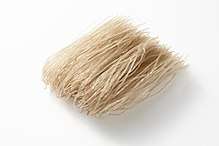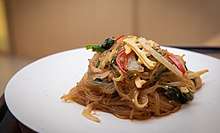Cellophane noodles
Cellophane noodles, or fensi (simplified Chinese: 粉丝; traditional Chinese: 粉絲; pinyin: fěnsī; lit.: 'flour thread'), sometimes called glass noodles, are a type of transparent noodle made from starch (such as mung bean starch, potato starch, sweet potato starch, tapioca, or canna starch) and water.
 Cooked cellophane noodles | |
| Alternative names | Glass noodles |
|---|---|
| Type | Noodles |
| Place of origin | China[1] |
| Region or state | East Asia, Southeast Asia |
| Associated national cuisine | China, Indonesia, Japan, Korea, Malaysia, Philippines, Samoa, Thailand, United States, Vietnam, and Taiwan |
| Main ingredients | Starch (from mung beans, yams, potatoes, cassava, canna, or batata), water |
| Regional name | |
|---|---|
| Chinese name | |
| Traditional Chinese | 粉絲 |
| Simplified Chinese | 粉丝 |
| Literal meaning | flour thread |
| Hanyu Pinyin | fěnsī |
| Wade–Giles | fên3-ssŭ1 |
| Yale Romanization | fán sī |
| Jyutping | fan2 si1 |
| Chinese name (Taiwan) | |
| Chinese | 冬粉 |
| Literal meaning | winter flour |
| Hanyu Pinyin | dōngfěn |
| Bopomofo | ㄉㄨㄥㄈㄣˇ |
| Wade–Giles | tung1-fên3 |
| Hokkien POJ | tang-hún |
| Vietnamese name | |
| Vietnamese | miến / bún tàu |
| Literal meaning | noodle / Chinese vermicelli |
| Thai name | |
| Thai | วุ้นเส้น / เส้นแกงร้อน / ตังหน |
| RTGS | wun sen / sen kaeng ron / tung hon |
| Korean name | |
| Hangul | 당면 |
| Hanja | 唐麵 |
| Literal meaning | Tang noodle |
| Revised Romanization | dangmyeon |
| McCune–Reischauer | tangmyŏn |
| North Korean name | |
| Chosŏn'gŭl | 분탕 |
| Hancha | 粉湯 |
| Literal meaning | flour soup |
| Revised Romanization | buntang |
| McCune–Reischauer | punt'ang |
| Japanese name | |
| Kanji | 春雨 |
| Kana | はるさめ |
| Revised Hepburn | harusame |
| Indonesian name | |
| Indonesian | sohun |
| Filipino name | |
| Tagalog | sotanghon |
They are generally sold in dried form, soaked to reconstitute, then used in soups, stir-fried dishes, or spring rolls. They are called "cellophane noodles" or "glass noodles" because of their cellophane- or glass-like transparency when cooked. Cellophane noodles should not be confused with rice vermicelli, which are made from rice and are white in color rather than clear (after cooking in water).
Varieties
Cellophane noodles are made from a variety of starches. In China, cellophane noodles are usually made of mung bean starch. Chinese varieties made from mung bean starch are called Chinese vermicelli, bean threads, or bean thread noodles. Thicker Korean varieties made with sweet potato starch are called sweet potato noodles or dangmyeon.
Cellophane noodles are available in various thicknesses. Wide, flat cellophane noodle sheets called mung bean sheets are also produced in China. In Korea, napjak-dangmyeon (literally "flat dangmyeon") refers to flat sweet potato noodles.
- Dried Chinese vermicelli made with mung bean starch
 Dried Korean dangmyeon made with sweet potato starch
Dried Korean dangmyeon made with sweet potato starch Dōng běi dà lā pí made with Chinese mung bean sheets
Dōng běi dà lā pí made with Chinese mung bean sheets Napjak-dangmyeon in jjimdak
Napjak-dangmyeon in jjimdak
Production
In China, the primary site of production of cellophane noodles is the town of Zhangxing, in Zhaoyuan, Shandong province. However, historically the noodles were shipped through the port of Longkou, and thus the noodles are known and marketed as Longkou fensi (simplified Chinese: 龙口粉丝; traditional Chinese: 龍口粉絲).[2]
Use
East Asia
China

In Chinese, the most commonly used names are fěnsī (Chinese: 粉絲, literally "noodle thread") and dōngfěn (Chinese: 冬粉, literally "winter noodle"). They are also marketed under the name saifun, the Cantonese pronunciation of the Mandarin xìfěn (Chinese: 細粉; literally "slender noodle"), though the name fánsī (粉絲) is the term most often used in Cantonese.
In China, cellophane noodles are a popular ingredient used in stir fries, soups, and particularly hot pots. They can also be used as an ingredient in fillings for a variety of Chinese jiaozi (dumplings) and bing (flatbreads), especially in vegetarian versions of these dishes. Thicker cellophane noodles are also commonly used to imitate the appearance and texture of shark's fin in vegetarian soups. Thicker varieties, most popular in China's northeast, are used in stir fries as well as cold salad-like dishes. A popular soup using the ingredient is fried tofu with thin noodles (Chinese: 油豆腐線粉湯; Pinyin: yóu dòu fu-xiàn fěn tāng). A popular Sichuan dish called ants climbing a tree consists of stewed cellophane noodles with a spicy ground pork meat sauce.
In Tibetan cuisine of Tibet Autonomous Region, glass noodles are called phing or fing and are used in soup, pork curry or with mushrooms.
Japan
In Japanese cuisine, they are called harusame (春雨), literally "spring rain". Unlike Chinese glass noodles, they are usually made from potato starch. They are commonly used to make salads, or as an ingredient in hot pot dishes. They are also often used to make Japanese adaptations of Chinese and Korean dishes. Shirataki noodles are translucent, traditional Japanese noodles made from the konjac yam and sometimes tofu.
Korea

In Korean cuisine, glass noodles are usually made from sweet potato starch and are called dangmyeon (Hangul: 당면; Hanja: 唐麵; literally "Tang noodles"; also spelled dang myun, dangmyun, tang myun, or tangmyun). They are commonly stir-fried in sesame oil with beef and vegetables, and flavoured with soy and sugar, in a popular dish called japchae (hangul: 잡채). They are usually thick, and are a brownish-gray color when in their uncooked form.
South Asia
India
In India and Pakistan, glass noodles are called falooda (see falooda, the dessert dish), and are served on top of kulfi (a traditional ice cream). They are usually made from arrowroot starch using a traditional technique. The noodles are flavorless so they provide a nice contrast with the sweet kulfi. Kulfi and falooda can be bought from numerous food stalls throughout Pakistan and northern parts of India.
Southeast Asia
Indonesia
In Indonesian cuisine, they are called soun or suun.
Malaysia
In Malaysia they are known as tanghoon (冬粉). They are sometimes confused with bihun (米粉) which are rice vermicelli. Sometimes also known as suhun or suhoon.
Philippines
In Filipino cuisine, the noodles are called a similar name: sotanghon because of the popular dish of the same name made from them using chicken and wood ears. They are also confused with rice vermicelli, which is called bihon in the Philippines.
Thailand
In Thai cuisine, glass noodles are called wun sen (Thai: วุ้นเส้น). They are commonly mixed with pork and shrimp in a spicy salad called yam wun sen (Thai: ยำวุ้นเส้น), or stir-fried as phat wun sen (Thai: ผัดวุ้นเส้น).
Vietnam
In Vietnamese cuisine, there are two varieties of cellophane noodles. The first, called bún tàu or bún tào, are made from mung bean starch, and were introduced by Chinese immigrants. The second, called miến or miến dong, are made from canna (Vietnamese: dong riềng), and were developed in Vietnam. These cellophane noodles are a main ingredient in the dishes: miến gà, miến lươn, miến măng vịt, and miến cua. These cellophane noodles are sometimes confused with rice vermicelli (Vietnamese: bún) and arrowroot starch noodles (Vietnamese: arrowroot: củ dong, arrowroot starch: bột dong/bột hoàng tinh/bột mì tinh).
Oceania
Samoa
Glass noodles were introduced to Samoa by Cantonese agricultural workers in the early 1900s where they became known as "lialia", a Samoan word meaning "to twirl", after the method of twirling the noodles around chopsticks when eating. A popular dish called sapasui (transliteration of the Cantonese chop suey) is common fare at social gatherings. Sapasui, a soupy dish of boiled glass noodles mixed with braised pork, beef, or chicken and chopped vegetables, is akin to Hawaiian "long rice".
North America
United States
In Hawaii, where cuisine is heavily influenced by Asian cultures, cellophane noodles are known locally as long rice, supposedly because the process of making the noodles involves extruding the starch through a potato ricer.[3] They are used most often in chicken long rice, a dish of cellophane noodles in chicken broth that is often served at luaus.[4]
Health concerns
In 2004, a number of companies producing Longkou cellophane noodles produced in Yantai, Shandong were discovered to be adulterated, with unscrupulous companies making noodles from cornstarch instead of green beans in order to reduce costs; the companies, to make the cornstarch transparent, were adding sodium formaldehyde sulfoxylate and lead-based whiteners to their noodles.[5]
In December 2010, Czech food inspection authorities (SZPI) again inspected Chinese cellophane noodles, this time determining that 142 mg/kg (0.00227 oz/lb) of aluminium had been used in the production of the noodles.[6] Above 10 mg/kg (0.00016 oz/lb) is an illegal amount for noodles in Czech and EU markets (see Annex I to Regulation (EC) No 669/2009 and its amendments (EU) No 187/2011, 618/2013 annex I).
See also
References
- Hulin, Belinda (November 10, 2009). Knack Chinese Cooking. Globe Pequot Press. p. 150. ISBN 9780762758463.
- "China Vermicelli Manufacturer - Yantai Yinsida Longkou Vermicelli Co., Ltd". made-in-china.com. Archived from the original on 2007-09-27.
- Keiko Ohnuma (Apr 25, 2007). "The choice is clear". Honolulu Star-Bulletin. Archived from the original on June 14, 2008.
- "Chicken Long Rice". 'Ono Kine Grindz. TypePad. October 27, 2005. Archived from the original on September 27, 2007.
- Yunxiang Yan (2015). "From Food Poisoning to Poisonous Food: The Spectrum of Food-Safety Problems in Contemporary China". In Kwang Ok Kim (ed.). Re-orienting Cuisine: East Asian Foodways in the Twenty-First Century. Berghahn Books. p. 272.
- "Archived copy". Archived from the original on 2011-07-18. Retrieved 2010-12-16.CS1 maint: archived copy as title (link)